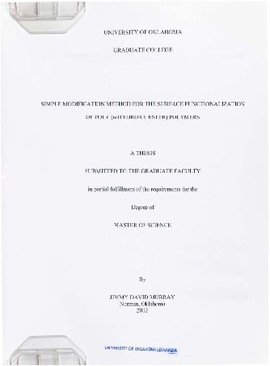| dc.contributor.author | Murray, Jimmy David | |
| dc.date.accessioned | 2019-12-23T18:00:11Z | |
| dc.date.available | 2019-12-23T18:00:11Z | |
| dc.date.created | 2012 | |
| dc.date.issued | 2012 | |
| dc.identifier.uri | https://hdl.handle.net/11244/323251 | |
| dc.description | Thesis (M.S.)--University of Oklahoma, 2012. | |
| dc.description | Includes bibliographical references (leaves 40-49). | |
| dc.description.abstract | A vital component for the engineering of tissue constructs in vitro is a scaffold that allows cells to adhere and proliferate. Biomimetic scaffolds aim to enhance the regeneration of damaged tissue by mimicking the cells' natural environment. This study investigated the potential of surface functionalization of PLA films. PLA fibers were modified using an acetone-water mixture to physically entrap amine functionalized polyK uniformly. Biomimetic modification was achieved with linking of biological molecules
using amine coupling chemistry (amine to carboxylic acid using a carbodiimide).Uniform surface coverage of entrapped and linking molecules was shown using fluorescent microscopy. Process flexibility is demonstrated with cellular response to surface modification using HE, HA, and RGD. Initial cell response was investigated with a statically attached cell culture of rMSC's, F-actin staining, and fluorescent microscopy. This imaging showed surface modification enhanced cell attachment, cell stretching, and can potentially signal cell differentiation. Expansion of the process to more materials
showed a preference for amorphous structure over crystallinity in poly (a -hydroxy esters). This process is a simple method for uniform surface modification that is nondestructive to the scaffold and can be used to attach many biological molecules (proteins, peptides, and GAG 's) in order to present a cell friendly surface. | |
| dc.format.extent | xii, 49 leaves | |
| dc.format.medium | xii, 49 leaves : ill. (chiefly col.) ; 29 cm. | |
| dc.language.iso | eng | |
| dc.subject.lcsh | Tissue engineering | |
| dc.subject.lcsh | Biomedical materials | |
| dc.subject.lcsh | Guided tissue regeneration | |
| dc.title | Simple modification method for the surface functionalization of poly (α-hydroxy ester) polymers | |
| dc.type | Text | |
| dc.contributor.committeeMember | Shambaugh, Robert | |
| dc.contributor.committeeMember | O'Rear, Edgar | |
| dc.contributor.committeeMember | Sikavitsas, Vassilios | |
| ou.group | Department of Bioengineering | |
